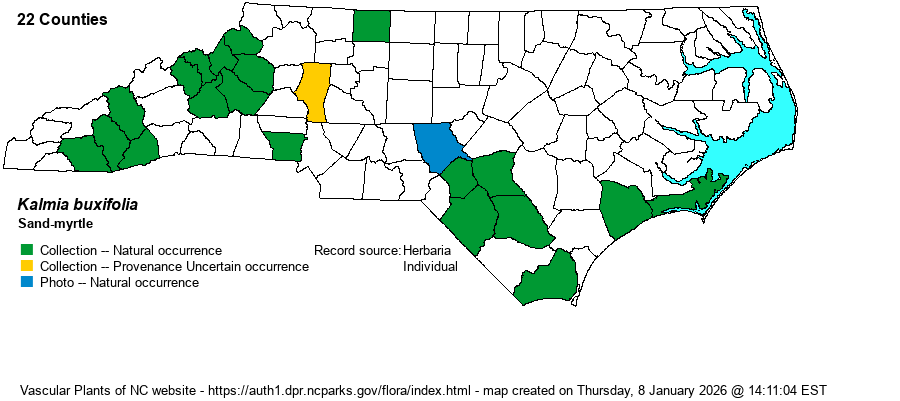| Author | (Bergius) Gift, Kron, & Stevens | |
| Distribution | It has a strongly bimodal distribution, and even within the Coastal Plain it is bizarrely absent from some suitable areas. It occurs in the southern 35% of the Coastal Plain, northeast to Carteret County and into the southwestern Coastal Plain, where numerous along Rockfish Creek in Hoke, Robeson, and Cumberland counties. It is then disjunct to exposed sites in the Piedmont foothills and the mountains. Absent from most of the Piedmont and the northern 65% of the Coastal Plain. A curious population was discovered by Alicia Jackson in southern Moore County in 2019.
This has one of the more bizarre ranges of any plant. There is a cluster of records from southeastern NY to southern NJ, and then it “skips over” DE, MD, and VA, to “re-occur” from northern NC to northeastern GA and west only to southeastern KY and eastern TN. NC has the majority of the occurrences of this species.
| |
| Abundance | Highly local in the Coastal Plain, but where found it can occur in extensive stands, such as in the Boiling Spring Lakes area of Brunswick County. Generally rare otherwise in this province. In the mountains and foothills, generally rare to uncommon and limited to exposed, rocky summits. | |
| Habitat | In the Coastal Plain, it has two main habitats: damp but sandy pine forests, such as Wet Pine Flatwoods; and drier and sandier upland pine stands in the western part of the province (such as Mesic Pine Flatwoods). In the western part of the state it grows only on exposed, rocky summits and outcrops, on many rock types – mainly at high elevations. | |
| Phenology | Blooms mainly from late March into May, and occasionally into the fall; it fruits in September and October. | |
| Identification | This is a very easily identified species. It is a fairly low, evergreen shrub, reaching about 3 feet tall, at least in the Coastal Plain; on montane outcrops and domes, it usually ranges only to about 2 feet tall. Its tiny (less than 1/2-inch long), thick and shiny leaves, which are entire and elliptical, and its stiff branches are enough for identification. It does have a distinctive flower cluster at the tips of the branches, composed of small five-petaled white flowers. | |
| Taxonomic Comments | One of the more controversial shifts of a species from one genus to another is the moving of this species – formerly Leiophyllum buxifolium, in its own genus no less – into the genus Kalmia, with Mountain Laurel and various other “wicky” and “sheep laurel” species. Though the flowers and inflorescences are quite different from typical Kalmia species, taxonomists have reasons for this re-classification. This species had often been split into varieties, one for the Coastal Plain population and one for the mountains and foothills; RAB (1968) listed L. buxifolium var. buxifolium for the Coastal Plain, and L. buxifolium var. prostratum for the western form. However, Weakley (2018) and many recent references do not list varieties for it.
| |
| Other Common Name(s) | Generally none, other than the mixed use of a hyphen, two words, etc. | |
| State Rank | S3 | |
| Global Rank | G4 | |
| State Status | | |
| US Status | | |
| USACE-agcp | FACU link |
| USACE-emp | FACU link |

